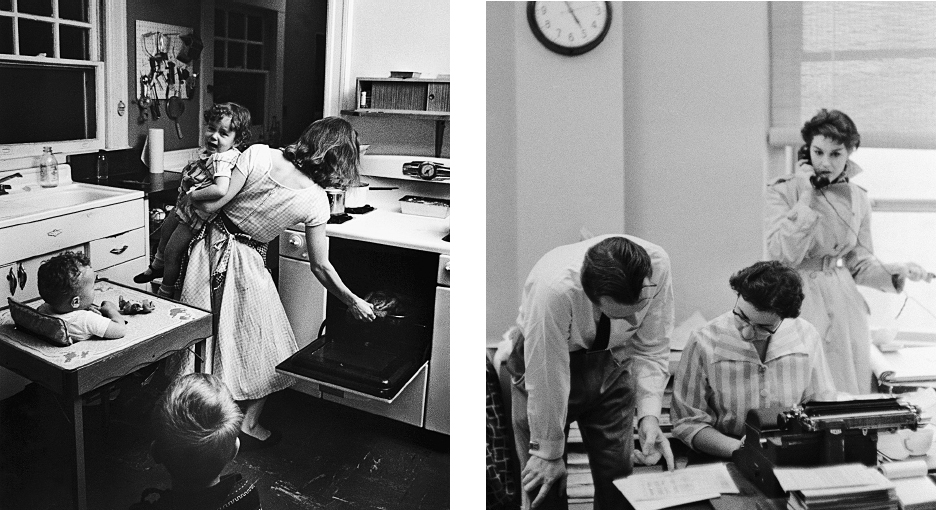America’s History: Printed Page 851
America: A Concise History: Printed Page 773
America’s History: Value Edition: Printed Page 754
Women, Work, and Family
Two powerful forces shaped women’s relationships to work and family life in the postwar decades. One was the middle-class domestic ideal, in which women were expected to raise children, attend to other duties in the home, and devote themselves to their husbands’ happiness. So powerful was this ideal that in 1957 the Ladies’ Home Journal entitled an article, “Is College Education Wasted on Women?” The second force was the job market. Most working-class women had to earn a paycheck to help their family. And despite their education, middle-class women found that jobs in the professions and business were dominated by men and often closed to them. For both groups, the market offered mostly “women’s jobs” — in teaching, nursing, and other areas of the growing service sector — and little room for advancement (American Voices).
The idea that a woman’s place was in the home was, of course, not new. The postwar obsession with femininity and motherhood bore a remarkable similarity to the nineteenth century’s notion of domesticity. The updated version drew on new elements of twentieth-century science and culture. Psychologists equated motherhood with “normal” female identity and suggested that career-minded mothers needed therapy. “A mother who runs out on her children to work — except in cases of absolute necessity — betrays a deep dissatisfaction with motherhood or with her marriage,” wrote one leading psychiatrist. Television shows and movies depicted career women as social misfits. The postwar consumer culture also emphasized women’s domestic role as purchasing agents for home and family. “Can a woman ever feel right cooking on a dirty range?” asked one advertisement.

The postwar domestic ideal held that women’s principal economic contribution came through consumption — women shopped for the family. In reality, their contributions increasingly took them outside their homes and into the workforce. In 1954, married women made up half of all women workers. Six years later, the 1960 census reported a stunning fact: the number of mothers who worked had increased four times, and over one-third of these women had children between the ages of six and seventeen. In that same year, 30 percent of wives worked, and by 1970, it was 40 percent. For working-class women, in particular, the economic needs of their families demanded that they work outside the home.
Despite rising employment rates, occupational segmentation still haunted women. Until 1964, the classified sections of newspapers separated employment ads into “Help Wanted Male” and “Help Wanted Female.” More than 80 percent of all employed women did stereotypical women’s work as salesclerks, health-care technicians, waitresses, stewardesses, domestic servants, receptionists, telephone operators, and secretaries. In 1960, only 3 percent of lawyers and 6 percent of physicians were women; on the flip side, 97 percent of nurses and 85 percent of librarians were women. Along with women’s jobs went women’s pay, which averaged 60 percent of men’s pay in 1963.
Contrary to stereotype, however, women’s paid work was not merely supplementary. It helped lift families into the middle class. Even in the prosperous 1950s, many men found that their wages could not pay for what middle-class life demanded: cars, houses, vacations, and college education for the children. Many families needed more than one wage earner just to get by. Among married women, the highest rates of labor-force participation in the 1950s were found in families at the lower end of the middle class. Over the course of the postwar decades, from 1945 to 1965, more and more women, including married women, from all class backgrounds, entered the paid workforce.
How could American society steadfastly uphold the domestic ideal when so many wives and mothers were out of the house and at work? In many ways, the contradiction was hidden by the women themselves. Fearing public disapproval, women would explain their work in family-oriented terms — as a way to save money for the children’s college education, for instance. Moreover, when women took jobs outside the home, they still bore full responsibility for child care and household management, contributing to the “double day” of paid work and family work. As one overburdened woman noted, she now had “two full-time jobs instead of just one — underpaid clerical worker and unpaid housekeeper.” Finally, the pressures of the Cold War made strong nuclear families with breadwinning fathers and domesticated mothers symbols of a healthy nation. Americans wanted to believe this even if it did not perfectly describe the reality of their lives.
TRACE CHANGE OVER TIME
Question
What transformations in women’s economic role took place in the 1950s and 1960s?